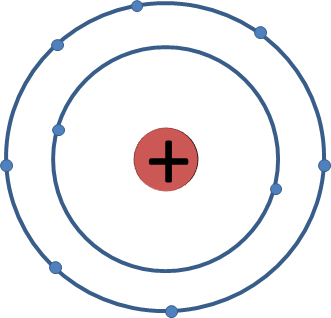Repulsion of valence layer electron pairs, RPECV
Repulsión de pares electrónicos de capa de valencia (RPECV) o también conocido como VSEPR es la geometría que forma las moléculas o las redes covalentes.
The chemical physicist Gilbert Newton Lewis proposed the covalent bond between atoms in 1916. This bond is produced by the sharing of electron pairs. This means that each atom gets 8 electrons in the valence shell.
A clear example is the fluorine atom which has 7 electrons in the electronic valence shell.

In a structure, it is very difficult to distinguish the geometry, both the molecular geometry and the degree to which the bonds form each other. This is why the theory of repulsion of the electron pairs in the valence layer is used to determine the geometry of molecules. It was not until 1970 Gillespie that this theory made it easier to distinguish between geometry and angles.
The valence shell electron pair repulsion model
The RPECV model explains that since electrons repel each other because they are negatively charged, geometry can reduce the repulsions between the different electron pairs around the central atom.
Valencia’s electron pair repulsion theory is the exemplar in chemistry for the shape of molecules, which is based on the degree of electrostatic repulsion of the electron pairs.
As we can see below, there are different types of molecular geometry:
Trigonal Bipyramid
See-saw
T
Linear
| Molecular geometry | Hybridisation of the A atom | Angle -A- |
| Trigonal Bipyramid | Sp3d | 90/120 |
| See-saw | Sp3d | 90/120 |
| T | Sp3d | 90/120 |
| Linear | Sp3d | 90/120 |
Types of repulsion
There are 3 types of repulsion between the electrons of a molecule:
- Non-bonding pair – non-bonding pair repulsion
- Non-bonding pair – bonded pair repulsion
- Bonded pair – bonded pair repulsion
The non-bonding pair repulsion is considered free, whereas the bonding pair repulsion must have a chemical bond.
Depending on the number of electrons in the valence shell we can see one arrangement of electrons or another.
| NUMBER OF VALENCE ELECTRON PAIRS | ARRANGEMENT OF ELECTRON PAIRS |
| 2 | Linear |
| 3 | Flat trigonal |
| 4 | Tetrahedral |
| 5 | Trigonal Bipyramid |
| 6 | Octahedron |
A clear example of the valence shell electron pair repulsion theory is ammonia (NH3). Ammonia has three bound electrons and one lone pair. The lone electrons affect the geometry by repulsion. The NH3 molecule is part of the AB3E group and has an E due to the unpaired electron pair.